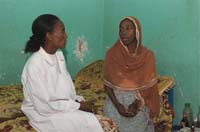2.4.2 Self-empowerment
Your role as a Health Extension Practitioner will be to help individuals in your community make healthy choices. It’s important to remember that self-empowerment is rooted in awareness and understanding that people can act to change their own lives on their own behalf (Figure 2.6). Using the self-empowerment approach you can provide the tools they will need to make their own choices about their health and increase their control over their physical, social and psychological environment. Self-empowerment techniques include, but are not limited to, group work, problem solving, client-centered counselling, assertiveness training, social skills training and educational drama. You will learn more about these techniques in future study sessions.

Suppose that you as Health Extension Practitioner planned to create awareness amongst your community members on the problems of tuberculosis. Write down some of the ways you can create awareness about tuberculosis and so help people to begin to act positively for themselves.
You may have thought of some of the following ways:
- Health education sessions are important for the community to reduce transmission of tuberculosis by helping people to understand how to break the route of transmission.
- A health education session would help you to identify those people with signs and symptoms of tuberculosis and encourage them to take action and visit a larger health facility for diagnosis.
- Your health education session could encourage patients who are already on anti-TB medication to adhere to their treatment, which is a form of personal action which will help prevent drug-resistant TB.
2.4.1 Behaviour change
